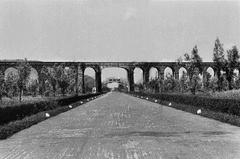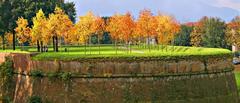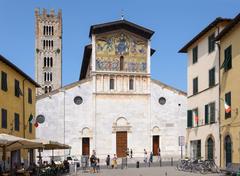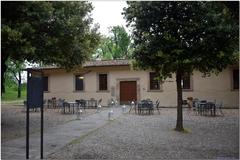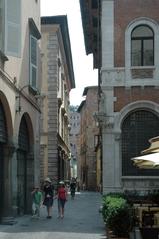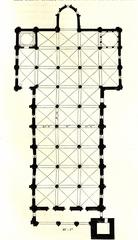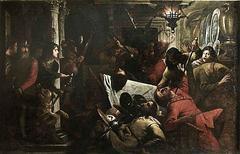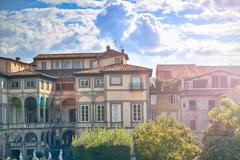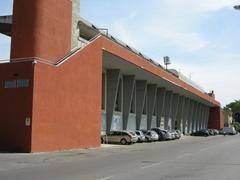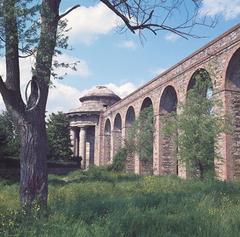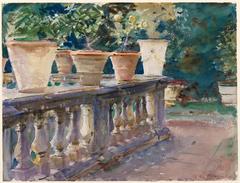Gabinetto di Storia Naturale del Liceo Machiavelli Lucca: Visitor Guide, Hours, Tickets, and Collections
Date: 14/06/2025
Introduction
Located within the historic Palazzo Lucchesini in the center of Lucca, the Gabinetto di Storia Naturale del Liceo Machiavelli is an extraordinary example of a 19th-century natural history collection preserved in its original educational context. Established as part of Lucca’s scientific and educational reforms, the museum offers a rare opportunity to explore centuries-old specimens, scientific instruments, and historical exhibits that reflect the evolution of scientific inquiry in Tuscany.
This comprehensive guide details the museum’s history, collections, visitor information—including visiting hours, ticketing, and accessibility—and practical travel tips. Whether you are a science enthusiast, cultural traveler, or a local resident, the Gabinetto di Storia Naturale provides a fascinating window into Italy’s scientific heritage.
Table of Contents
- Introduction
- Historical Overview
- Collections and Features
- Museum Layout and Display Philosophy
- Visitor Information
- Frequently Asked Questions (FAQ)
- Conclusion and Final Recommendations
- Sources
Historical Overview
Origins and Early Development
The foundation of the Gabinetto di Storia Naturale dates back to the late 18th century, when the Republic of Lucca sought to establish a university. The Pio Istituto di San Frediano, founded in 1785, marked the beginning of organized scientific study in the city. By 1790, a chair of chemistry was established, supported by a collection of scientific instruments and specimens, laying the groundwork for what would become the Gabinetto di Storia Naturale (Brunelleschi IMSS).
The Real Collegio and Scientific Expansion
A major evolution occurred in 1819 under Duchess Maria Luisa di Borbone, with the establishment of the Real Collegio in Palazzo Lucchesini. This institution featured a botanical garden, astronomical observatory, and specialized cabinets for physics, anatomy, and natural history. These resources became central to public education in the Duchy of Lucca and were regularly showcased in city guides (Brunelleschi IMSS).
19th-Century Academic Growth
By the mid-19th century, the Real Collegio had become a university-level institution with three faculties—Legal, Medical-Surgical, and Physical-Mathematical. This academic prestige was further cemented by the granting of degrees and advanced scientific instruction (Brunelleschi IMSS).
Transformation into the Gabinetto di Storia Naturale
Following the annexation of Lucca to the Grand Duchy of Tuscany in 1847 and Italy’s unification, the school transitioned into the Liceo Classico. The natural history collections were designated as the Gabinetto di Storia Naturale del Liceo Machiavelli, continuing their educational mission within the historic Palazzo Lucchesini (Brunelleschi IMSS).
Collections and Features
Mineralogy and Paleontology
The mineralogical and paleontological collections are among the oldest in the museum. They include hundreds of mineral specimens and a rich array of fossils, many acquired through donations and purchases throughout the 19th century. These collections illustrate the geological diversity of Tuscany and serve as valuable educational resources for both students and the public (viaggiart.com, anms.it PDF).
Zoological Collections
Ornithology
A particular highlight, the ornithological collection contains hundreds of taxidermied bird specimens, both local and exotic. The display, which has grown through 19th-century donations and acquisitions, is central to the Gabinetto’s educational and scientific mission (anms.it PDF).
Mammalogy
The mammalogy section includes notable specimens such as a buffalo skeleton and various mammals, preserved and displayed in original glass cases. These specimens offer insight into 19th-century taxidermy and zoological study (anms.it PDF).
Herpetology and Ichthyology
The Gabinetto possesses significant herpetological and ichthyological collections, with dozens of reptiles, amphibians, and fish displayed in jars and cases. These collections reflect the region’s biodiversity and the collecting practices of the 19th century (anms.it PDF).
Malacology and Entomology
The malacological and entomological collections were built primarily through private donations and acquisitions. They feature a wide range of shells, mollusks, and insects, representing both local and exotic fauna (viaggiart.com).
Cetacean Highlights
Bottlenose Dolphin Skeleton
A standout specimen is the complete skeleton of a common bottlenose dolphin (Tursiops truncatus), mounted in the third room. Its provenance is unknown, but it is considered one of the rare historical cetacean skeletons displayed in an Italian school museum (anms.it PDF).
Mysticete Vertebrae
The museum also houses two large lumbar vertebrae from a baleen whale (mysticete), underscoring the ambition and scientific scope of the original Gabinetto founders (anms.it PDF).
Scientific Instruments and Archival Materials
An extensive collection of historical scientific instruments—microscopes, balances, demonstration models, and glassware—illustrates the evolution of scientific education from the 19th century onward. The museum’s archives contain handwritten catalogues and correspondence documenting the provenance of key specimens (Musei di Lucca).
Museum Layout and Display Philosophy
The Gabinetto is organized into six rooms, largely preserving the original 1857 architectural and display design. Wooden and glass cabinets, period furnishings, and handwritten labels create an immersive “cabinet of curiosities” atmosphere. This historic layout is central to the museum’s identity and visitor experience (anms.it PDF).
Visitor Information
Location and Access
- Address: Via degli Asili, 35, 55100 Lucca, Italy (Palazzo Lucchesini)
- Access: Main entrance on Via degli Asili, elevator access available
Visiting Hours and Booking
- By Appointment Only: The Gabinetto operates primarily as an educational resource. Public visits are by appointment, typically during school hours (7:30 AM – 3:30 PM, weekdays).
- Special Events: The museum opens during city-wide events such as “Notte dei Licei Classici” and “Notti Bianche.”
- How to Book: Contact +39 0583 496471 or email [email protected]. Check official website for updates and special opening times.
Tickets and Admission
- Admission: Free of charge. Donations are welcome and support preservation activities.
- Groups/Guided Tours: Guided tours, often led by staff or students, are available by prior arrangement.
Accessibility
- Facilities: Elevator access at the entrance; restrooms available; some areas may be limited due to building structure.
- Special Needs: Notify the museum of specific accessibility requirements when booking.
Guided Tours and Special Events
- Guided tours are available in Italian (basic English explanation possible upon request).
- Workshops and temporary exhibitions are occasionally organized during festivals and events.
Facilities and Nearby Attractions
- Location: Central Lucca, close to the city walls, Lucca Cathedral, Orto Botanico, and major piazzas.
- Amenities: Nearby cafés, restaurants, and shops; public transport and parking options outside the city walls.
Travel Tips
- Advance Booking: Essential due to limited public hours.
- Visit Duration: 45–90 minutes recommended.
- Photography: Permitted in most areas without flash; check policies upon arrival.
- Combine with Other Sites: The Gabinetto is ideally paired with visits to Lucca’s historic walls, towers, and gardens.
Frequently Asked Questions (FAQ)
Q: What are the Gabinetto di Storia Naturale visiting hours?
A: By appointment during weekdays (7:30 AM–3:30 PM) and during special public events. Check the official website for current information.
Q: Is there an admission fee?
A: Admission is free; donations are appreciated.
Q: Are guided tours available?
A: Yes, by advance booking. Tours are often led by school staff or students.
Q: Is the museum accessible to visitors with disabilities?
A: Generally accessible with elevator access, but please notify the museum when booking to discuss any special needs.
Q: Can I take photographs?
A: Photography is generally permitted without flash; confirm policy during your visit.
Q: How do I get there?
A: The museum is in Lucca’s pedestrian center, accessible by foot, public transport, or bicycle. Parking is available outside the city walls.
Conclusion and Final Recommendations
The Gabinetto di Storia Naturale del Liceo Machiavelli stands as a living testament to Lucca’s scientific and educational legacy. Its authentic 19th-century collections, displayed within a historic school setting, offer an unparalleled journey into the history of natural sciences. Whether you are a student, scholar, or curious traveler, a visit promises an enriching encounter with Tuscany’s cultural and scientific heritage.
Plan your visit in advance, take advantage of guided tours, and explore the museum’s unique atmosphere—an inspiration for anyone fascinated by the intersection of science, education, and history. For the most accurate and up-to-date information, always consult the official museum website and related cultural platforms.
Download the Audiala mobile app for audio tours and explore Lucca’s historical sites even further. Follow us on social media for updates and event announcements.
Sources
- Liceo Classico Niccolò Machiavelli - Gabinetto di Storia Naturale (Brunelleschi IMSS)
- Musei di Lucca - Gabinetto di Storia Naturale
- Istituto Machiavelli – Gabinetto di Storia Naturale
- Comune di Lucca – Museo di Scienze Naturali
- ViaggiArt: Gabinetto di Storia Naturale del Liceo Machiavelli
- ANMS Italian Natural History Museums Association, PDF
- Official Gabinetto di Storia Naturale Website
- The Crazy Tourist – Best Things to Do in Lucca, Italy
